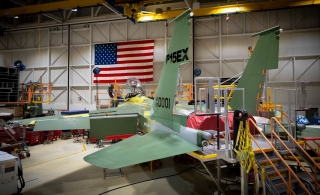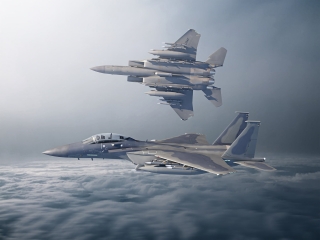The USAF's F-15EX future is bright. The doubts about numbers and basing explained
(5 minute read)
Recently the US Air Force layed out its plans to replace the aging McDonnell Douglas (Boeing) F-15C/D Eagles with the service’s future Boeing F-15EX. Following up the April 2019 Justification and Approval (J&A), multiple bases across the US are now named to become the host of the new Eagle clone. (The exact name and/or type for Boeing's F-15EX is not known at this moment).
With the first two F-15EXs, 20-0001 and 20-0002, already well under construction at Boeing's plant at St. Louis (MO), it is expected delivery of these aircraft is scheduled for early 2021. The USAF states the first six to eight F-15EXs will be fielded at Eglin AFB (FL) by 2023, to be used for developmental and operational testing. It has been decided that these will be converted in a later stadium to be used as combat coded airframes. In practice, this means the developmental and operational testing F-15EXs will be administratively placed under command of the 53rd Wing, but will be often found at other bases, such as Edwards AFB (CA), Nellis AFB (NV) and Palmdale/Plant 42 (CA).
On 13 July 2020, the USAF gave Boeing a huge USD 1,2 billion award for the first eight Low Rate Initial Production (LRIP) F-15EX's. A clause has also been drawn up immediately which also set a not-to-exceed ceiling of USD 22,89 billion for up to 200 of Boeing's F-15EX fighters. The fiscal year 2021 budget request includes twelve more aircraft and up to 72 airframes are planned over the next four years. Although the USAF’s minimum quantity has been set at 144 airplanes, Scramble assesses, assuming everything goes according to plan, the remaining 56 F-15EXs will likely be requested.
As for the numbers: according to our Scramble Database there are now 234 operational F-15C/D Eagles in the USAF's inventory. Roughly twenty of them are being used for testing and evaluations. The F-15C/Ds are aging rapidly. The fleet is expected to reach the end of service life by the mid-2020s. Except for about fourteen, the total number of 200 future F-15EXs would suit the USAF just fine. A decision to also refresh F-15E Strike Eagle fleet has not yet been made, but this remains an option.
The F-15EX configuration is largely based on the F-15QA Qatar Foreign Military Sales (FMS) configuration, but with added USAF capabilities. What are those extra capabilities? Scramble assesses there are some main abilities involved. As a fourth-generation fighter with all its advanced capacities, like a new electronic warfare suite, the F-15EX could perfectly operate alongside the fifth-generation F-35A. The F-15EX would even complement the F-35A: the twin-engined F-15EX is big, fast and has a big reach. It can carry larger weapons over greater distances than the smaller, less aerodynamic F-35A. Provided the weight and dimensions can be kept moderate, the USAF and Boeing expect the F-15EX, with its new mission computer, will be compatible with the hypersonic Lockheed Martin AGM-183 missile (see also: https://www.facebook.com/Scramblemagazine/posts/3890534167639755). The F-15EX would then represent a major threat deterrent to future opponents. Another capability for the F-15EX will be the long-range air-to-air Lockheed Martin AIM-260 Joint Advanced Tactical Missile. The AIM-260 is to achieve initial operating capability in 2022. It is said to have a range of over 200 kilometers.
With these capabilities in mind, it is now clear what the USAF is trying to achieve by basing the F-15EX at various bases throughout the Continental United States (CONUS). Although all operational Air National Guard (ANG) F-15 units have been deployed to Europe as a Theater Security Package (TSP) over the past few years, their main task is, and will continue to be, to defend the CONUS. The Oregon ANG's 123rd Fighter Squadron, part of the recently redesignated 142nd Wing, based at Portland Air National Guard Base (OR), will be the first operational F-15EX unit in 2023. Defending that part of the west of the CONUS is among the highest priorities. Strategically located on the southeast side of the CONUS, Florida's 159th Fighter Squadron, part of the 125th Fighter Wing at Jacksonville International Airport (FL), will not receive the F-15EX, but definitely have the F-35A Lightning II based in 2024.
The first fielding, after the developmental and operational testing F-15EXs, will be with the 114th Fighter Squadron, part of the 173rd Fighter Wing at Kingsley Field (OR). The latter will host the USAF’s first F-15EX formal training mission, beginning in 2022.
In 2019, the USAF justified the F-15EX procurement as follows: the nine existing F-15C/D Eagle squadrons - three in the active Air Force (Lakenheath UK and Kadena (Japan) and six in the Air National Guard - could reequip with the new F-15EX planes on short notice. This, however, seems to be hanging in the balance since the USAF also plans to replace the remaining Air National Guard operational F-15C/D bases (Barnes Airport, Massachusetts, Fresno Yosemite Airport, California, and Naval Air Station Joint Reserve Base New Orleans) with either F-35As or F-15EXs. Naval Air Station Lemoore, California, is also being considered for F-35As. Earlier, Scramble Facebook News wrote about the roughly 50 legacy Eagles based at Kadena (Japan). These are still considered high on the priority list to be replaced by the F-15EX as well.
To be continued.




